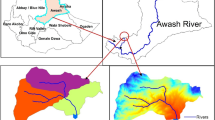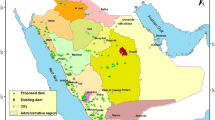Abstract
A unified and systematic approach for hydrological modeling is presented for assessing flood hazards in arid and semi-arid regions with wadi Itwad as a case study. The approach consists of the following steps: (1) estimation of the design storm duration, (2) estimation of the design rainfall depth, (3) development of the design storm hyetograph, (4) setup of the watershed hydrological system, (5) infiltration tests for estimate of soil characteristics, (6) land use and land cover analysis for curve number estimation, (7) how to incorporate dams (if any) and their reservoir characteristics for reservoir routing analysis, and (8) performing hydrological modeling under different scenarios, namely: lumped with and without the effect of dams and routed scenarios. An emphasis is made on the comparison between the SCS unit hydrograph and the unit hydrograph (UH) estimated for stream flow data. The UH method produces hydrographs that are typical of arid regions. It is characterized by a steep rising limb with a short time to peak, a rapid recession to zero base flow, and less flood volume due to transmission losses. The scenarios show that the lumped case overdesigns the protection schemes, while the lumped central basin with detention dams storing the flood water completely leads to underdesign in the downstream area. The routed scenario is more realistic, since it considers the detention dams with an overflow. The runoff volume (66.6 MCM) of the 10-year return period of the routed scenario is in the order of magnitude within the observed historical data (50 to 100 MCM) reported in the literature. The study concludes that the proposed approach is robust and takes into account the Saudi arid environment while performing flood risk assessment in KSA.















Similar content being viewed by others
References
Akay H, Baduna Kocyigit M, Yanmaz AM (2018) Effect of using multiple stream gauging stations on hydrologic parameters and estimation of hydrograph of ungauged neighboring basin. Arab J Geosci 11:282
Al Qahtani M and Matter Y (2018). Development of surface water resources and rainwater harvesting in Saudi Arabia. Third Water Arabian Conference, Kuwait. Book of Abstracts, pp. 72.
Al-Ammawi FA, Al-Harthi SG, Al-Zahrani MI, Bulki A, Abu Abdullah M and Şen Z, (2010) Potential flood hazards in Wadi Itwad, southwest Saudi Arabia: Saudi Geological Survey Technical Report SGS-TR-2008-1, 30 p.
Al-Turki S (1995) Water resources in Saudi Arabia with particular reference to Tihama Asir province, Durham theses, Durham University. Available at Durham E-Theses Online: http://etheses.dur.ac.uk/5127/. Accessed Oct 2018
Albishi, M. (2015). Unit hydrograph of watersheds in arid zones: case study in south western Saudi Arabia. Unpublished MSc. thesis, King Abdulaziz University, Jeddah.
Albishi M, Bahrawi J, Elfeki A (2017) Empirical equations for flood analysis in arid zones: the Ari-Zo model. Arab J Geosci 10:51. https://doi.org/10.1007/s12517-017-2832-4
Azeez O, Elfeki A, Kamis AS, Chaabani A (2019) Dam break analysis and flood disaster simulation in arid urban environment: the Um Al-Khair dam case study, Jeddah, Saudi Arabia. Nat Hazards. https://doi.org/10.1007/s11069-019-03836-5
Baduna Koçyiğit M, Akay H, Yanmaz AM (2017a) Effect of watershed partitioning on hydrologic parameters and estimation of hydrograph of an ungauged basin: a case study in Gokirmak and Kocanaz, Turkey. Arab J Geosci 10:331
Baduna Koçyiğit M, Akay H, Yanmaz AM (2017b) Estimation of hydrologic parameters of Kocanaz watershed by a hydrologic model. Int J Eng Appl Sci 9(4):42–50
Berndtsson R (1987) Application of infiltration equations to a catchment with large spatial variability in infiltration. Hydrol Sci J 32(3):399–413
Boorman DB, Reed DW (1981). Derivation of a catchment average unit hydrograph, report 71, Institute of Hydrology.
Borland WM, Miller CR (1958) Distribution of sediment in large reservoirs. J Hydraul Div 84(2):1587.1–1587.10
Elfeki A, Bahrawi J (2017) Application of the random walk theory for simulation of flood hazards: Jeddah flood 25 November 2009. Int J Emerg Manag 13(2):169–182
Elfeki A, Al-Shabani A, Bahrawi J, Alzahrani S (2018). Quick urban flood risk assessment in arid environment using HECRAS and dam break theory: case study of Daghbag dam in Jeddah, Saudi Arabia. Recent Advances in Environmental Science from the Euro-Mediterranean and Surrounding Regions, 01/2018: pages 1917-1919, ISBN: 978-3-319-70547-7, DOI:https://doi.org/10.1007/978-3-319-70548-4_553.
Elfeki A, Masoud M, Niyazi B (2017) Integrated rainfall-runoff and flood inundation modeling for flash flood risk assessment under data scarcity in arid regions: Wadi Fatimah basin case study, Saudi Arabia. Nat Hazards J 85(1):87–109
Elfeki A, Ewea HA, Bahrawi JA and Al-Amri NS (2014). A convection-decay model for simulating the transmission of flood waves in ephemeral channels in arid zones (2014). 6 International Conference on Water Resources and the Arid Environments (ICWRAE 6): 328-333, 16-17 December, 2014, Riyadh, Saudi Arabia.
Ewea H, Elfeki A, Al-Amri N (2016a). Development of intensity–duration–frequency curves for the Kingdom of Saudi Arabia. Geomatics, Natural Hazards and Risk, 11/2016; https://doi.org/10.1080/19475705.2016.1250113.
Ewea H, Elfeki AM, Bahrawi JA, Al-Amri N (2016b) Sensitivity analysis of runoff hydrographs due to temporal rainfall patterns in Makkah Al-Mukkramah region, Saudi Arabia. Arab J Geosci 9:424. https://doi.org/10.1007/s12517-016-2443-5
Farran MM, Elfeki AM (2019) Variability of the asymptotic curve number in mountainous undeveloped arid basins based on historical data: case study in Saudi Arabia. J Afr Earth Sci. https://doi.org/10.1016/j.jafrearsci.2019.103697
Farran MM, Elfeki AM (2020a) Statistical analysis of NRCS curve number (NRCS-CN) in arid basins based on historical data. Arab J Geosci 13:31. https://doi.org/10.1007/s12517-019-4993-9
Farran MM, Elfeki AM (2020b) Evaluation and validity of the antecedent moisture condition (AMC) of Natural Resources Conservation Service-Curve Number (NRCS-CN) procedure in undeveloped arid basins. Arab J Geosci 13:275. https://doi.org/10.1007/s12517-020-5242-y
Fernadez D, Lutz M (2010) Urban flood hazard zoning in Tucumán Province, Argentina, using GIS and multicriteria decision analysis. Eng Geol 111(1–4):90–99
Guzzetti F, Tonelli G (2004) Information system on hydrological and geomorphological catastrophes in Italy (SICI): a tool for managing landslide and flood hazards. Nat Hazards Earth Syst Sci 4:213–232
He YP, Xie H, Cui P, Wei FQ, Zhong DL, Gardner JS (2003) GIS-based hazard mapping and zonation of debris flows in Xiaojiang Basin, southwestern China. Environ Geol 45(2):286–293
Horton R (1933) The role of infiltration in the hydrological cycle. Trans AGU 14:446–460
Horton R (1939) Analysis of runoff-plot experiments with varying infiltration capacity. Trans AGU 20:693–711
Kamis AS, Bahrawi JA, Elfeki AM (2018) Reservoir routing in ephemeral streams in arid regions. Arab J Geosci 11:106. https://doi.org/10.1007/s12517-018-3440-7
Kite GW (1977) Frequency and risk analysis in hydrology. Water Resources Publications, USA
Masoud M (2015) Rainfall–runoff modeling of ungauged Wadis in arid environments (case study Wadi Rabigh – Saudi Arabia). Arab J Geosci 8(5):2587–2606. https://doi.org/10.1007/s12517-014-1404-0
Masoud M, Niyazi B, Elfeki A, and Zaidi S (2014). Mapping of flash flood hazard prone areas based on integration between physiographic features and GIS techniques (case study of Wadi Fatimah, Saudi Arabia) 6th International Conference on Water Resources and the Arid Environments (ICWRAE 6): 334-347, 16-17 December, 2014, Riyadh, Saudi Arabia.
Masoud M, Schumann S, Mogheeth SA (2013) Estimation of groundwater recharge in arid, data scarce regions; an approach as applied in the El Hawashyia basin and Ghazala sub-basin (Gulf of Suez, Egypt). Environ Earth Sci 69:103–117. https://doi.org/10.1007/s12665-012-1938-y
Merzi N, Aktas MT (2000) Geographic information systems (GIS) for the determination of inundation maps of Lake Mogan. Turkey Water Int 25(3):474–480
Mohammadzadah-Habili J, Heidarpour M, Mousavi S, Haghiabi A (2009) Derivation of reservoir’s area-capacity equations. J Hydrol Eng 14(9):1017–1023
Noor K, Elfeki A (2017) Development of a generalized Hayami solution for modelling of a diffusive flood wave in arid and non-arid regions. Nat Hazards 88(1):121–144
Niyazi B, Elfeki A, Masoud M, and Zaidi S. (2014). Spatio-temporal rainfall analysis at Wadi Fatima for flood risk assessment. 6th international conference on water resources and the arid environments (ICWRAE 6): 308-314, 16-17 December, 2014, Riyadh, Saudi Arabia.
Philip JR (1957a) The theory of infiltration. 1. The infiltration equation and its solution. Soil Sci 83:345–357
Philip JR (1957b) The theory of infiltration. 4. Sorptivity and algebraic infiltration. Soil Sci 84:257–264
Philip JR (1958) The theory of infiltration. 7. Soil Sci 85:333–337
Sanyal J, Lu X (2006) GIS-based flood hazard mapping at different administrative scales: a case study in Gangetic West Bengal, India. Singap J Trop Geogr 27:207–220
Sorman AU, Qari MYHT, Hassani MM (1994) Estimation of flood peaks using remote sensing techniques; case study: Wadi Itwad, southwestern Saudi Arabia. J King Abdulaziz Univ: Metrology, Environmental and Arid Land Agriculture Sciences 5:161–177
Sui DZ, Maggio RC (1999) Integrating GIS with hydrological modeling: practices, problems, and prospects. Comput Environ Urban Syst 23:33–51
USDA-SCS (1985) National engineering handbook section 4: hydrology, soil conservation service. USDA, Washington
USDA-SCS (1963) National engineering handbook section 4: hydrology, soil conservation service. USDA, Washington
Van Mullem JA (1989) Applications of the Green-Ampt infiltration model to watersheds in Montana and Wyoming. MSc. thesis Montana State University, Bozeman
Walter MO (1989) A unique flood event in an arid zone. J Hydrol Process 3(1):15–24
Zerger A, Smith DI (2003) Impediments to using GIS for real-time disaster decision support. Comput Environ Urban Syst 27:123–141
Acknowledgments
The authors acknowledge with thanks DSR for technical and financial support.
Funding
This project was funded by the Deanship of Scientific Research (DSR), King Abdulaziz University, Jeddah, under grant no. G-393-155-438.
Author information
Authors and Affiliations
Corresponding author
Additional information
Responsible Editor: Amjad Kallel
Rights and permissions
About this article
Cite this article
Elfeki, A., Masoud, M., Basahi, J. et al. A unified approach for hydrological modeling of arid catchments for flood hazards assessment: case study of wadi Itwad, southwest of Saudi Arabia. Arab J Geosci 13, 490 (2020). https://doi.org/10.1007/s12517-020-05430-7
Received:
Accepted:
Published:
DOI: https://doi.org/10.1007/s12517-020-05430-7




